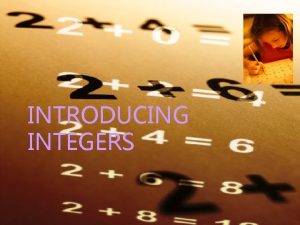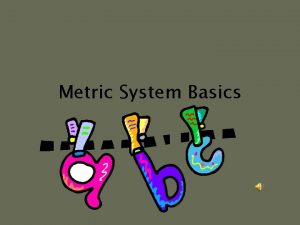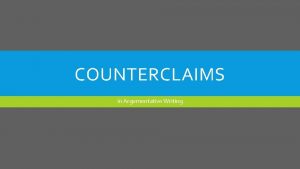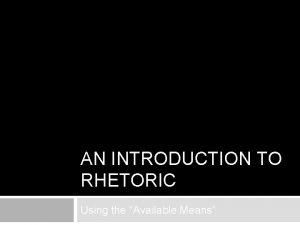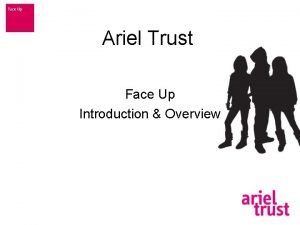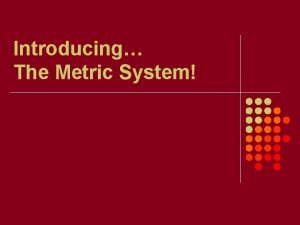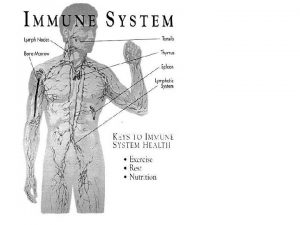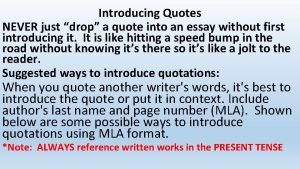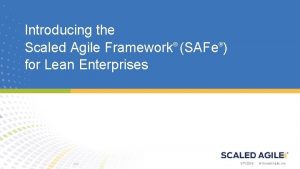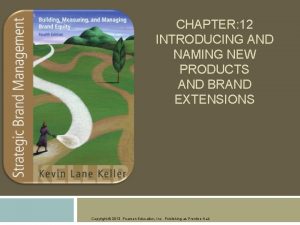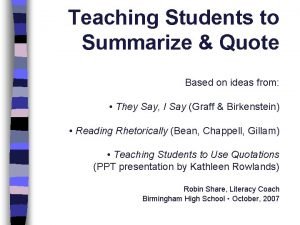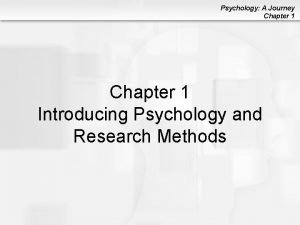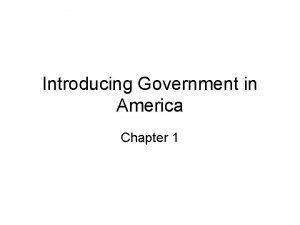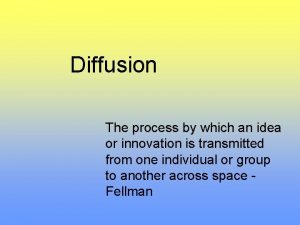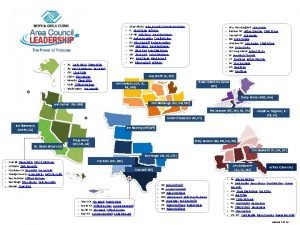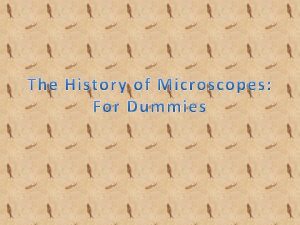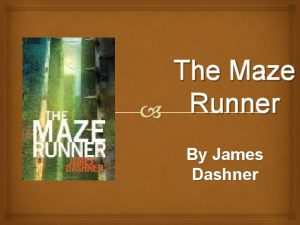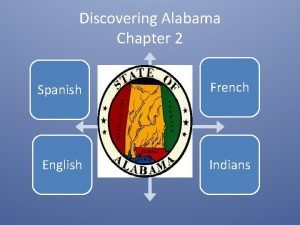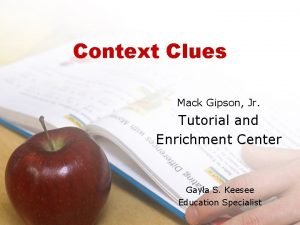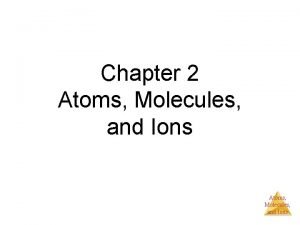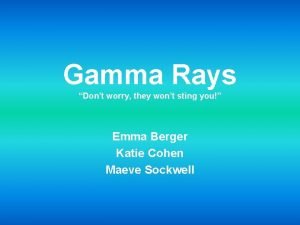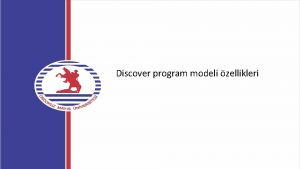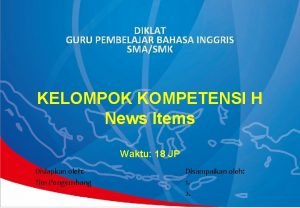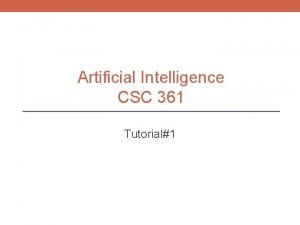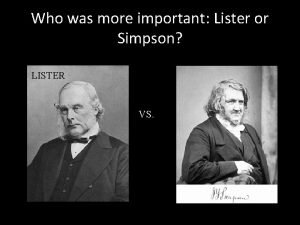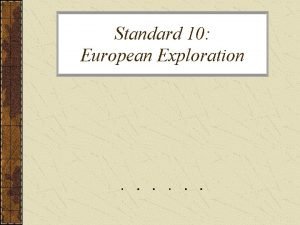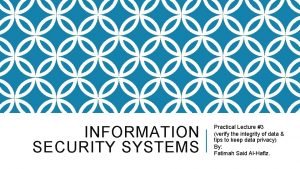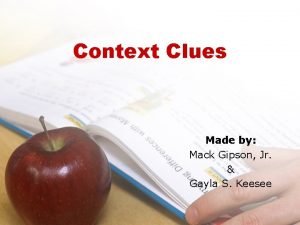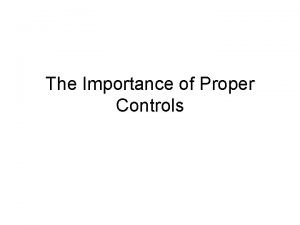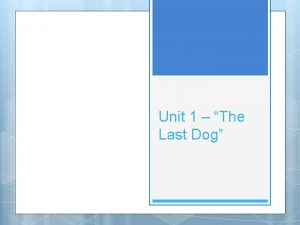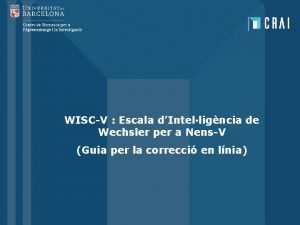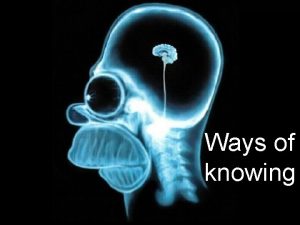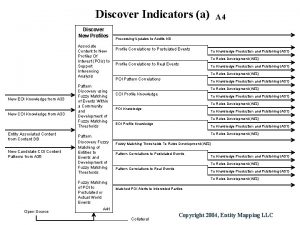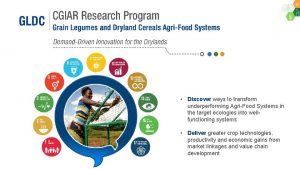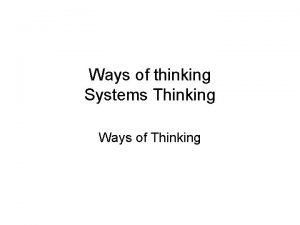INTRODUCING THE WISCV Discover all the ways WISCV













































































































- Slides: 109

INTRODUCING THE WISC-V Discover all the ways WISC-V delivers increased flexibility and more content.

AGENDA • Overview of Changes from WISC-IV to WISC-V • New Test Structure and Technical Properties • New subtests and retained content with revisions • Administering on Q-I, Demonstration of New Subtests on Q-i and generating reports

Administration and Scoring Options Paper/Pencil Format Hand-score Q-global Scoring & Reporting Digital Format Automatic Scoring & Reporting via Q-interactive

Why Transition to WISC-V? Coverage: Choice: Linked: Structure: Increased Training: Feedback: Time: Choice of coverage Statistically linked Presents a 5 -factor of cognitive training Briefer Decreased testing traditional paper to. Basic the KTEA-3 and structure. processes related to included with the instructions, time to obtain FSIQ and pencil or the WIAT-III, with SLD Identification. kit. Flexibility to implementing and primary index digital format. combination Supports a begin testing to fit developmentally scores. scoring reports processing strength your schedule. appropriate The digital format available. andlanguage. weakness recognizes the analysis child as aapproach. digital native and provides a positive and enjoyable format.

Why Transition to WISC-V? ü A choice of traditional paper and pencil or digital format. ü Increased coverage of cognitive processes related to SLD Identification. Supports a processing strengths and weakness analysis approach. ü Statistically linked to the KTEA-3 and the WIAT-III, with combination scoring reports available! ü Presents a 5 -Factor structure. ü Basic training included with the kit. ü Decreased testing time to obtain FSIQ and primary index scores. ü Briefer instructions, using developmentally appropriate language. 5

DEVELOPMENT OF THE WISC-V: REVISION GOALS – A SUMMARY 6

WISC-V Revision Goals • • • Update theoretical foundations Increase user friendliness Increase developmental appropriateness Improve psychometric properties Enhance clinical utility • What do these revision goals really mean? 7

1. Update Theoretical Foundations • Increase breadth of construct coverage by investigating and developing: – – visual spatial subtest fluid reasoning subtest visual working memory subtests to measure additional processes related to learning (naming facility, associative memory) • to measure additional cognitive processes relevant to learning disabilities 8

Importance of Clinical Neuropsych Assessment 9

Importance of Working Memory • Working memory is important to the measure of cognitive functioning – related to fluid reasoning (Burgess & Braver, 2010; Hornung, 2011; Martinez et al. , 2011) – implicated in a wide variety of academic problems and clinical conditions affecting children and adolescents (e. g. , Archibald & Gathercole, 2006 a, 2007; Borella, Caretti, & Pellegrina, 2010; Hutchinson, Bavin, Efron, & Sciberras, 2012; Fitzpatrick & Pagini, 2012) 10

The WISC-V and the DSM-5 • Clinical studies adhere to DSM-5 criteria changes – – – – Intellectual Disability Mild and Moderate Borderline Intellectual Functioning Specific Learning Disorder – Reading and Written Expression Specific Learning Disorder - Mathematics ADHD Autism Spectrum Disorder-With Language Impairment Autism Spectrum Disorder-Without Language Impairment • Nonverbal Index (NVI) – Some DSM-5 conditions: nonverbal measure of ability necessary to establish criteria – ID established, language disorder under consideration – Language impairment estab. , ID being considered, cannot obtain valid VC subtest scores, need NVI

Theoretical Foundations • Numerous structural models of intelligence – Wechsler considers various models (one of which is Cattell. Horn-Carroll [CHC]) – Example: An expansion of Vernon’s hierarchical model produces superior CFA results in some studies (Johnson & Bouchard, 2005 a; 2005 b; Johnson, te Nijenhuis, & Bouchard, 2007) • Wechsler model accounts for important aspects of cognitive ability that these models converge upon • CHC theory is still evolving • CHC theory does not account for important lessons we learn from working memory models (Multicomponent model, Baddeley, 2000, 2002, 2012; Embedded-processes model, Cowan, 1988; Towse & Cowan, 2005) • Neurodevelopmental models • Clinical utility (#1) Copyright © 2014 Pearson Education, Inc. or its affiliates. All rights reserved.

CHC Taxonomy, Index Scores Index Score CHC Broad Ability (Narrow) VCI Gc VSI Gv FRI Gf WMI Gsm (MW, MS) PSI Gs QRI Gf (RQ), Gq AWMI Gsm (MW, MS) NSI Glr (NA) STI Glr (MA) SRI Glr

Primary Index Scores Headline placed here Text here… VCI VSI FRI Perceptual Reasoning Index (PRI) Replaced WMI PSI

2. Increase Developmental Appropriateness • Instructions – Reduce vocabulary level, verbosity • ceiling items on Similarities • “Advantages” and other high vocabulary level of items on Comprehension – Demonstrate, practice, and teach the task • Replace outdated art and items with more current and relevant 15

2. Increase Developmental Appropriateness 16

3. Increase User Friendliness Reduce testing time – 5 primary index scores: 65 minutes mean (10 minutes shorter than WISC-V mean) – FSIQ: 48 minutes mean (27 minutes shorter than WISC-V mean) – Shorter discontinue rules, fewer items, selecting subtests with briefer admin time to contribute to these scores – FSIQ subtests does not include all Primary Index subtests – Provide testing time for various percentages of normative sample by age and special group samples to complete each subtest 17

4. Improve Psychometric Properties • • • Items and scoring rules Norms and norming method Maintain or improve reliability Floors and ceilings Reevaluate item bias – Iterative psychometric analyses – Qualitative reviews by experts 18


New Descriptive Classifications Composite Score Range 130 and above 120– 129 110– 119 90– 109 80– 89 70– 79 69 and below WISC–V Descriptive Classification Extremely High Very High Average Low Average Very Low Extremely Low

WISC-V TRAINING URLs • (Password = Go. W 5) • Module 1: Verbal Comprehension Subtests • https: //www. brainshark. com/pearsonassessments/W 5 VC • Module 2: Fluid Reasoning Subtests • https: //www. brainshark. com/pearsonassessments/W 5 FR • Module 3: Visual Spatial Subtests • https: //www. brainshark. com/pearsonassessments/W 5 VS • Module 4: Working Memory Subtests • https: //www. brainshark. com/pearsonassessments/W 5 WM

WISC-V-TRAINING URLs • • Module 5: Processing Speed Subtests https: //www. brainshark. com/pearsonassessments/W 5 PS • • Module 6: WISC-V Complementary Subtests https: //www. brainshark. com/pearsonassessments/W 5_Complementary • • Module 7: Scoring and Basic Interpretation https: //www. brainshark. com/pearsonassessments/W 5_Interp • • Module 8: WISC-V Technical Information https: //www. brainshark. com/pearsonassessments/W 5_Tech Module 9: A Case Study (later release) https: //www. brainshark. com/pearsonassessments/W 5_Case

WISC-V- Q-I TRAINING URLs • Module 1: Administration of the WISC-V using Q-interactive – The basics • https: //www. brainshark. com/pearsonassessments/W 5 Qi_Basics • • • Module 2: VCI Subtests on Q-i https: //www. brainshark. com/pearsonassessments/W 5 Qi_VCI Module 3: FRI Subtests on Q-i https: //www. brainshark. com/pearsonassessments/W 5 Qi_FRI Module 4: VSI Subtests on Q-i https: //www. brainshark. com/pearsonassessments/W 5 Qi_VSI Module 5: WMI Subtests on Q-i https: //www. brainshark. com/pearsonassessments/W 5 Qi_WMI https: //www. brainshark. com/pearsonassessments/W 5 PS

WISC-V- Q-I TRAINING URLs • • • • Module 6: PSI Subtests on Q-i https: //www. brainshark. com/pearsonassessments/W 5 Qi_PSI Module 7: WISC-V Complementary Subtests on Q-i https: //www. brainshark. com/pearsonassessments/W 5 Qi_Complementary Module 8: Generating Reports and Essential Steps to Interpretation https: //www. brainshark. com/pearsonassessments/W 5 Qi_Interp Module 9: WISC-V on Q-interactive: Technical Information https: //www. brainshark. com/pearsonassessments/W 5 Qi_Tech Module 9: A Case Study (later release) https: //www. brainshark. com/pearsonassessments/W 5 Qi_Case

4. Improve Psychometric Properties • Significance level options for critical values • Increased statistical evidence of cultural fairness – Collect home environment questionnaire and convey results – Increase available information on impact of SES (e. g. , urban vs. rural schools) 25

Choosing the Level of Significance More stringent Less stringent

5. Enhance Clinical Utility • Provide subtests to measure cognitive processes known to be clinically sensitive to learning disabilities to enhance pattern of strengths and weaknesses (PSW) approach to learning disability evaluation – Rapid Naming – Paired Associates (Verbal-Visual) • Provide “PSW” link in joint software with WIAT -III and KTEA-3 27

Enhance Clinical Utility (cont’d) • Test structure – Provide factor structure that simplifies interpretation (PRI→VSI/FRI) • Score differences comparison methodology – Both index- and subtest-level: Strengths and weaknesses then pairwise Copyright © 2014 Pearson Education, Inc. or its affiliates. All rights reserved.

WISC-V Test Structure

New 5 factor model • 5 Factor Model • Arithmetic on Fluid Reasoning, Crossloading on WM and VC Similarities Vocabulary Information Verbal Comprehension Block Design Visual Spatial Visual Puzzles Matrix Reasoning Full Scale Fluid Reasoning Figure Weights Picture Concepts Arithmetic Working Memory Digit Span Picture Span Letter-Number Sq Processing Speed Coding Symbol Search Cancellation Copyright © 2014 Pearson Education, Inc. or its affiliates. All rights reserved. 30

WISC-V Framework

Test Structure – Full Scale IQ (7 subtests) New Terminology blue = Primary (Core) italics = Secondary (Supplemental)

Test Structure – Primary Index Scales

Test Structure Ancillary Index Scales (for clinical conditions) Headline placed here Text here… QRI AWMI NVI GAI CPI

Quantitative Reasoning Index (QRI) • Measures ability to perform mental math operations and understand quantitative relationships • may be of special interest if child is suspected of having a specific learning disability in mathematics 35

Auditory Working Memory Index (AWMI) • Ability to register, maintain and manipulate information presented verbally • Purer measure of auditory working memory relative to the WMI • domain-specific storage components may be related to various clinical conditions 36

Nonverbal Index (NVI) fre e g a u ng Not la e • Measure of general intellectual ability that minimizes expressive language demands • Use with ELL, DHH, ASD w/ language impairment • When DSM– 5 requires nonverbal measure of ability to meet diagnostic criteria: -if a diagnosis of ID is established and a comorbid diagnosis of language disorder is being considered -if child is language impaired AND being considered for a diagnosis of ID, AND you cannot obtain valid scores on the VCI to get an FSIQ, use Nonverbal Index alternative (Raiford & Coalson, 2014) 37

General Ability Index (GAI) • Estimate of general intellectual ability that excludes working memory and processing speed subtests • Why GAI? Lower FSIQ score may mask meaningful differences between general cognitive ability (represented by FSIQ) and other cognitive functions (e. g. , achievement, memory) • Evaluate GAI scores vs FSIQ when testing children suspected of neurodevelopmental disorders- ADHD, language disorders, ASD • NAGC position paper recommends use of the GAI in gifted evaluations 38

Cognitive Proficiency Index (CPI) • Estimate of efficiency with which information is processed in the service of learning and reasoning • Comprised of WM and PS tasks- Working memory and processing speed are related in that working memory involves identification, registration, and manipulation of information in short-term memory, and processing speed relates to how quickly you can register that information into STM. • Low CPI seen w/LD 39

Test Structure- Complementary Index Scales (RAN and associative learning with a delayed memory component) Headline placed here Text here… NSI STI M=100; SD=15 SRI

Naming Speed Index (NSI) Literacy & Quantity • estimate of automaticity of basic naming ability • developed to enhance the assessment of children with suspected learning disabilities • closely associated with reading and spelling skill development, and has shown sensitivity to reading disabilities • Closely associated with math skill development, and has show sensitivity to math disabilities • Also sensitive to other neurodevelopmental conditions - ADHD, language disorders, ASD • not developed as a measure of intellectual ability 41

Symbol Translation Index (STI) Immediate, Delayed, Recognition • broad estimate of visual-verbal associative memory • Skill is related to reading decoding, word reading accuracy and fluency, text reading, and reading comprehension • related to math calculation and math reasoning • developed to enhance the assessment of individuals suspected of having learning problems or declarative memory impairment. • sensitive to dyslexia • not developed as a measure of intellectual ability 42

Storage and Retrieval Index (SRI) (based on the sum of standard scores for the NSI and the STI) • broad estimate of long-term storage and retrieval accuracy and fluency derived from a variety of tasks that assess cognitive processes associated with reading, mathematics, and writing • Long-term storage and retrieval is related to reading, math and writing disabilities 43

Complementary Scales NSI & STI 44

WISC-V Framework 7 3 2 5

Technical Properties

WISC-V Normative Sample 11 age groups n = 200 per group Total n = 2, 200 Nationally Stratified Sample Age; Sex Race/Ethnicity; PEL Geographic Region

WISC-V Normative Sample and US Population

WISC-V Normative Sample and Special Education Population Percentages of Normative Sample and U. S. Population by Special Education Classification Normative Sample U. S. Population Developmental Delay 0. 6 0. 7 Intellectual Disability 1. 6 0. 9 Specific Learning Disability 1. 7 4. 9 Speech/Language Impairment 1. 5 2. 9 Attention-Deficit/Hyperactivity Disorder 1. 1 5. 0 Gifted and Talented 1. 7 6. 7

Internal Consistency- Ch 4 Average Reliability Coefficient Composite Overall Average (rxxa) VCI . 92 VSI . 92 FRI . 93 WMI . 92 PSI . 88 FSIQ . 96 QRI . 95 AWMI . 93 NVI . 95 GAI . 96 CPI . 93

Internal Consistency Average Reliability Coefficient Composite Overall Average (rxxa) NSI . 90 STI . 94 SRI . 94

Evidence of Test-Retest Stability – Composite Scores Composite First Testing Second Testing Standard Difference VCI 98. 5 101. 6 . 24 VSI 98. 6 105. 3 . 45 FRI 98. 7 103. 6 . 37 WMI 98. 5 100. 9 . 17 PSI 100. 3 108. 2 . 52 FSIQ 98. 3 104. 3 . 44 QRI 99. 2 102. 4 . 24 AWMI 98. 7 100. 9 . 16 NVI 98. 5 105. 5 . 50 GAI 98. 0 103. 6 . 41 CPI 99. 3 105. 5 . 43 9 -82 days; mean interval 26 days

Evidence of Test-Retest Stability – Composite Scores (Complementary) Composite First Testing Second Testing Standard Difference NSL 98. 3 101. 5 . 20 NSco 93. 9 91. 1 -. 19 NSsco 96. 2 100. 8 . 28 NSln 98. 7 102. 7 . 27 NSQ 99. 7 100. 5 . 05 IST 97. 6 106. 3 . 58 DST 98. 0 106. 9 . 62 RST 98. 9 104. 4 . 39 NSI 98. 7 101. 0 . 14 STI 97. 7 106. 5 . 58 SRI 98. 1 104. 9 . 43

Evidence of Validity: Criterion Ability – WISC–IV – WPPSI–IV – WAIS–IV – KABC–II Achievement – KTEA– 3 – WIAT–III Adaptive Behavior – Vineland–II Behavior – BASC– 2 Parent Rating Scales

Correlations With WISC-IV Composite WISC-V Mean WISC-IV Mean Correlation VCI 102. 7 104. 3 . 85 VSI-PRI 102. 8 107. 3 . 66 FRI-PRI 104. 3 107. 3 . 63 WMI 101. 7 103. 0 . 65 PSI 103. 7 102. 3 . 71 FSIQ 104. 4 106. 0 . 86 AWMI-WMI 102. 5 103. 1 . 76 GAI 104. 0 106. 9 . 85 CPI 103. 2 103. 3 . 73 SIQ FSIQ= 1. 6; FRI= 3 n=242; ages 6 -16

Correlations With WPPSI-IV (2012) Composite WISC-V Mean WPPSI-IV Mean VCI 102. 7 104. 7 VSI-PRI 103. 2 104. 5 FRI-PRI 104. 2 106. 6 WMI 102. 9 103. 9 PSI 102. 5 103. 6 FSIQ 103. 8 104. 9 AWMI-WMI 102. 0 103. 9 NVI 103. 7 104. 9 GAI 104. 1 105. 9 CPI 103. 1 104. 3 n = 105; ages 6: 0 -7: 7 . 83 FSIQ

Correlations With WAIS-IV Composite WISC-V Mean WAIS-IV Mean VCI 102. 2 103. 2 VSI-PRI 102. 7 101. 6 FRI-PRI 101. 6 WMI 102. 7 100. 4 PSI 104. 6 102. 0 FSIQ 103. 2 102. 3 AWMI-WMI 102. 9 100. 4 GAI 102. 4 102. 7 CPI 104. 5 101. 5 n = 112; age 16 . 89 FSIQ

16 year old…. WISC or WAIS? • Below average or clinical dx = WISC • Above average = WAIS • Average- clinical judgment

Correlations With WIAT-III WISC-V Composite Oral Lang. Basic Read. Comp. & Fluency Math Fluency Total Achievement VCI . 78 . 53 . 65 . 60 . 53 . 36 . 74 VSI . 44 . 24 . 30 . 39 . 44 . 28 . 46 FRI . 33 . 30 . 25 . 33 . 45 . 31 . 40 WMI . 56 . 54 . 40 . 47 . 46 . 39 . 63 PSI . 22 . 19 . 36 . 33 . 41 . 51 . 34 FSIQ . 74 . 61 . 65 . 68 . 71 . 58 . 81 Written Exp. 66% shared variance n = 211; age 6 -16

KTEA-3 NSI. 51 w/Academic Fluency STI. 54 w/Sound-Symbol FSIQ. 82 w/overall ASB score

Clinical validity studies Intellectually Gifted Intellectual Disability-Mild Severity Attention-Deficit/ Hyperactivity Disorder Disruptive Behavior Intellectual Disability. Moderate Severity Traumatic Brain Injury Borderline Intellectual Functioning English Language Learners Specific Learning Disorders Autism Spectrum Disorder

Intellectually Gifted Clinical Mean Control Mean Diff. p value Std. Diff. VCI 127. 7 105. 8 -21. 97 <. 01 -1. 74 VSI 121. 2 105. 2 -15. 98 <. 01 -1. 35 FRI 120. 3 105. 1 -15. 26 <. 01 -1. 26 WMI 117. 9 104. 0 -13. 86 <. 01 -1. 16 PSI 112. 9 100. 4 -12. 44 <. 01 -. 92 FSIQ 127. 5 105. 7 -21. 85 <. 01 -2. 05 QRI 122. 1 104. 1 -18. 04 <. 01 -1. 55 AWMI 123. 0 105. 9 -17. 13 <. 01 -1. 32 NVI 122. 9 104. 6 -18. 28 <. 01 -1. 64 GAI 127. 1 106. 3 -20. 83 <. 01 -1. 88 CPI 118. 8 102. 1 -16. 73 <. 01 -1. 43 Composite n = 95; ages 6 -16

Intellectual Disability – Mild Clinical Mean Control Mean Diff. p value Std. Diff. VCI 66. 0 96. 1 30. 14 <. 01 2. 16 VSI 66. 0 101. 1 35. 14 <. 01 2. 82 FRI 67. 0 99. 3 32. 34 <. 01 2. 35 WMI 65. 1 98. 7 33. 60 <. 01 2. 64 PSI 71. 6 97. 3 25. 78 <. 01 1. 87 FSIQ 60. 9 98. 0 37. 07 <. 01 2. 92 QRI 64. 2 98. 1 33. 86 <. 01 2. 67 AWMI 62. 2 99. 2 36. 96 <. 01 2. 91 NVI 62. 1 99. 5 37. 40 <. 01 3. 02 GAI 63. 5 97. 9 34. 46 <. 01 2. 71 CPI 63. 4 97. 6 34. 19 <. 01 2. 66 Composite n = 74; ages 6 -16

Attention-Deficit Hyperactivity Disorder Composite Clinical Mean Control Mean Diff. VCI 97. 8 102. 7 -21. 97 . 05 . 40 VSI 97. 3 101. 5 -15. 98 . 14 . 28 FRI 97. 6 102. 6 -15. 26 . 06 . 38 WMI 94. 8 101. 7 -13. 86 <. 01 . 54 PSI 94. 2 99. 9 -12. 44 . 03 . 43 FSIQ 95. 6 102. 2 -21. 85 <. 01 . 61 QRI 94. 8 103. 1 -18. 04 <. 01 . 62 AWMI 95. 2 101. 4 -17. 13 <. 01 . 50 NVI 94. 4 101. 7 -18. 28 <. 01 . 57 GAI 97. 1 102. 3 -20. 83 . 03 . 43 CPI 92. 8 100. 8 -16. 73 <. 01 . 65 p value Std. Diff. n = 48; ages 6 -16 All subtypes (inattentive, hyperactive, combined) included; minimum 24 -hours without psychostimulant meds

Autism Spectrum Disorder w/language impairment Clinical Mean Control Mean Diff. p value Std. Diff. VCI 80. 4 104. 1 23. 68 <. 01 1. 47 VSI 82. 8 104. 4 21. 62 <. 01 1. 18 FRI 84. 3 101. 6 17. 30 <. 01 . 98 WMI 77. 6 104. 1 26. 47 <. 01 1. 57 PSI 75. 8 96. 9 21. 12 <. 01 1. 24 FSIQ 76. 3 102. 1 25. 82 <. 01 1. 52 QRI 78. 9 102. 5 23. 67 <. 01 1. 35 AWMI 72. 3 102. 4 30. 14 <. 01 1. 70 NVI 79. 9 102. 8 22. 86 <. 01 1. 33 GAI 81. 8 102. 9 21. 18 <. 01 1. 28 CPI 74. 4 100. 0 25. 62 <. 01 1. 59 Composite n = 30

Learning Disabled- Reading

Math- LD 67

WISC-V and SLD Identification Subtest and Index Relationship with Academic Achievement 68

Word Reading and Non-Word Reading • Word Reading – Indexes: VCI and AWMI – Subtest DS VC (IN, CO) – Complementary Measures • Delayed Symbol Translation • Naming Speed Literacy • Pseudoword Decoding – Indexes: VCI, WMI, NSI – Subtest DS VC (IN, CO) – Complementary Measures • Delayed Symbol Translation • Naming Speed Literacy

Reading Comprehension and Fluency • Reading Comprehension – Indexes: VCI, FRI and AWMI – Subtest SI, VC (CO), MR (AR) – Complementary Measures • Delayed Symbol Translation • Oral Reading Fluency – Indexes: VCI, NSI, AWMI – Subtest VC, CD, DS (LNS), SI – Complementary Measures • Naming Speed Literacy • Delayed Symbol Translation

Reading Indexes • Basic Reading – Indexes: VCI, AWMI, NSI – Subtest VC (IN), DS, AR – Complementary Measures • Naming Speed Literacy • Total Reading – Indexes: VCI, AWMI, SRI – Subtest DS, SI, VC (CO, IN), AR – Complementary Measures • Naming Speed Literacy • Delayed Symbol Translation

Math Calculation and Problem Solving • Numerical Operations – Indexes: QRI, PSI, AWMI, VCI – Subtest SI, CD, DS (AR), FW (AR) – Complementary Measures • Naming Speed Quantity (CD) • Math Problem Solving – Indexes: QRI, AWMI, VSI – Subtest DS, FW, CD (AR), BD, VC (AR) – Complementary Measures • Delayed Symbol Translation

Math Fluency and Total • Math Fluency – Indexes: QRI, PSI, AWMI, NSI – Subtests: CD, DS (AR), FW (AR) – Complimentary • Naming Speed Literacy • Naming Speed Quantity • Total Math – Indexes: VCI, FRI, and AWMI – Subtests: DS, CD, FW, SI, AR – Complimentary • Delayed Symbol Translation

General Administration and Scoring Rules

Standard Subtest Administration Order • Alternating indices • Maintain interest • FSIQ 1 st 75

SUBSTITUTION AND PRORATION 76

Substitution FSIQ Is the only score where substitution is permitted

FSIQ – allowable substitutions 78

Proration • May prorate to 6 subtests (from 7) • NO Proration for anything but FSIQ 79

Warning - reminder Can EITHER prorate FSIQ with 6 subtests OR can Substitute 1 subtest. CANNOT DO BOTH! 80

Maximum Number of Subtests with Raw Scores of 0 Permitted: FSIQ = FOUR out of SEVEN (if prorated to 6, then only 3) Primary Index Scales = 1 out of 2 Ancillary Index Scales (QRI, AWMI) = 1 out of 2 NVI = 3 out of 6 GAI = 3 out of 5 CPI = 2 out of 4 STI = 2 out of 3 If NSI or STI is missing do not compute SRI 81

WISC-V Retained Subtests with Revisions

Changes from WISC-IV 2003 83 Copyright © 2014 Pearson Education, Inc. or its affiliates. All rights reserved.

Dropped WISC–IV Subtests • Word Reasoning – Redundant measure of verbal comprehension (high correlation with Information) • Picture Completion – Construct not as representative of visual spatial ability as others (secondary verbal loading) • And we needed the space for new subtests…

Changes to Retained Verbal Comprehension Subtests Similarities Vocabulary Information Comprehension • Revised scoring rules with data-based queries • Reviewed vocabulary level (no more “advantages”) • New, contemporary item content • Updated art with increased international portability *“Why do people use passwords? ” *all items and item images are fake to protect the innocent Copyright © 2014 Pearson Education, Inc. or its affiliates. All rights reserved.

WISC-V NEW SUBTESTS

New Subtests to Extend Content Coverage and Clinical Utility • Visual Puzzles: Visual Spatial ability; Allows separation of WISC–IV Perceptual Reasoning Index into Visual Spatial Index and Fluid Reasoning Index • Figure Weights: Quantitative fluid reasoning • Picture Span: Visual working memory • Naming Speed Literacy Naming Speed Quantity. Expands Patterns of Strengths and Weaknesses (PSW) analysis for specific learning disability (SLD) identification or to provide further information about rapid automatized naming if the need is present • Immediate Symbol Translation Delayed Symbol Translation Recognition Symbol Translation. Expands PSW analysis for SLD identification or to provide further information about paired associate learning (visual-verbal associative memory) if the need is present Copyright © 2014 Pearson Education, Inc. or its affiliates. All rights reserved.

New Subtests Visual Spatial Index • Visual Puzzles Fluid Reasoning Index • Figure Weights Working Memory Index • • Picture Span Digit Span Sequencing added to Digit Span Complementary Subtests • • • Naming Speed Literacy Naming Speed Quantity Immediate Symbol Translation Delayed Symbol Translation Recognition Symbol Translation

Visual Puzzles Scoring Common error alert! circle responses for later analysis Copyright © 2014 Pearson Education, Inc. or its affiliates. All rights reserved.

Matrix Reasoning Administration and Scoring • • Shortened and simplified discontinue Instructions slightly briefer Most frequent admin error? : _______ Most frequent scoring error? : ________ Copyright © 2014 Pearson Education, Inc. or its affiliates. All rights reserved.

Figure Weights Scoring ← changing time limit reminder after item 18 Common error alert! circle response Copyright © 2014 Pearson Education, Inc. or its affiliates. All rights reserved.

Picture Concepts Administration and Scoring Common error alert! circle responses for later analysis Picture Concepts lore: “Alternate responses penalize GT and creative children” Most frequent admin errors? : _________ Copyright © 2014 Pearson Education, Inc. or its affiliates. All rights reserved.

Arithmetic Administration and Scoring • Cannot repeat: 1 -20 (child is told explicitly) • Can repeat: 21 -34 (child is told explicitly) – Questions longer, second half – Pause timing if repeating • Process observation ideas. . . Copyright © 2014 Pearson Education, Inc. or its affiliates. All rights reserved.

Digit Span Administration • Most frequent admin error: reading wrong speed or different tone/inflection across digits – 1 digit per second – Don’t chunk – Consistent tone, drop tone last digit read • Second most frequent admin error? – Why can’t I do that? • Third most frequent admin error? – Why can’t I do that? • What if child interrupts me while I’m reading numbers? • Digits may occur more than once per trial: one item on Forward, multiple trials on Sequencing • What if child fails the Sequencing qualifying item? Copyright © 2014 Pearson Education, Inc. or its affiliates. All rights reserved.

Digit Span Scoring Copyright © 2014 Pearson Education, Inc. or its affiliates. All rights reserved.

Picture Span Administration • Child views one or more pictures, then selects them in sequential order from a larger picture array • Two points for correct pictures in the correct order and one point for correct pictures in the incorrect order • Simple visual span task with proactive interference • Research indicates proactive interference increases processing demands of working memory tasks (Blalock & Mc. Cabe, 2011; Carroll, et al. , 2010) Admin Tips Remember to: Stimulus Page Response Page “Point to the pictures in the order I showed you. ” Copyright © 2014 Pearson Education, Inc. or its affiliates. All rights reserved.

Most common scoring error? Picture Span Scoring B D C Teaching Items Record Verbatim Responses changing exposure time reminder change in max point value Distinguishing between 1 and 2 points Longest Span Scores Copyright © 2014 Pearson Education, Inc. or its affiliates. All rights reserved.

Letter-Number Sequencing Administration • Teaching change: – teach to order numbers before letters first – then when multiple letters/numbers introduced, teach to sequence • Most frequent admin error? – 1 number or letter per second – Don’t chunk – Consistent tone, drop tone last character read • Second most frequent admin error? – Why can’t I do that? • What if child interrupts me while I’m reading numbers? • No rhyming characters on a single trial for improved error interpretation • Pop Quiz: Which letters and numbers do not appear on WISC-V Letter-Number Sequencing? • What if child fails either qualifying item? Copyright © 2014 Pearson Education, Inc. or its affiliates. All rights reserved.

Letter-Number Sequencing Scoring 1 B 2 C F 3 A 5 E 2 DON’T dc yet! For first two items, incorrect to say letters before numbers now Copyright © 2014 Pearson Education, Inc. or its affiliates. All rights reserved.

Coding Administration and Scoring • No major changes to administration (instructions a little briefer) • Two most frequent administration errors on Coding? ____________ • Most frequent scoring error on Coding? ________________ • What is a rotation error? • Brain teaser: Why is the Coding rotation error max raw score lower than the Coding max total raw score? • Why isn’t the rotation error score a scaled score? • Most frequent question about Coding norms Copyright © 2014 Pearson Education, Inc. or its affiliates. All rights reserved.

Symbol Search Administration and Scoring • Child now marks the matching symbol in search group instead of YES (YES removed) for improved process/error observation • #1#2 and #3 administration errors on Symbol Search? • What is a set error and a rotation error? How do I find them easily? NOT REAL ITEMS rotation error set error • • • Why aren’t the set error score and the rotation error scores scaled scores? #1 scoring error? Most frequent question about Symbol Search norms? Copyright © 2014 Pearson Education, Inc. or its affiliates. All rights reserved.

Symbol Search Scoring Copyright © 2014 Pearson Education, Inc. or its affiliates. All rights reserved.

Cancellation Administration and Scoring • No major changes to administration (instructions a little briefer) • Most frequent administration error on Cancellation? ____________ • Most frequent scoring error on Cancellation? ____________ • Remember to score: correct minus incorrect • Process scores: CAr (random) and CAs (structured) Copyright © 2014 Pearson Education, Inc. or its affiliates. All rights reserved.

Naming Speed Subtests • • Child names elements as quickly as possible Child takes two or three tasks, depending on age Each task has a sample item and a 2 -page test item Current rapid naming tasks are relatively less sensitive to math disability if comorbid reading disability excluded(Korkman, Kirk, & Kemp, 2007; Pauly, Linkersdörfer, Lindberg, Woerner, Hasselhorn, Lonnemann, 2011; Willburger, Fussenegger, Moll, Wood, & Landerl, 2008) • Quantity naming added to improve sensitivity to math disability (Pauly et al. , 2011; Willburger et al. , 2008) Copyright © 2014 Pearson Education, Inc. or its affiliates. All rights reserved.

2 From NSL Record Form Page 5 2 5 7 Copyright © 2014 Pearson Education, Inc. or its affiliates. All rights reserved.

Symbol Translation Subtests • Child learns symbol-word pairs and translates symbols into learned meanings • Measure visual-verbal associative memory, which is related to reading, written expression, and math skills • Immediate, Delayed, and Recognition Symbol Translation subtests • Immediate ST teaches visual-verbal pairs in a stepwise manner, with repetition of associations introduced in the previous step, then recalls the learned associations by translating symbol strings • Delayed ST administered 20 to 30 minutes after completion of Immediate subtest, recalls the learned associations from Immediate • Immediate ST: learning and recall task • Delayed ST: recall • AND and THE (no credit after Item 6) • Recognition ST: recognize meaning from four read aloud while viewing the symbol Copyright © 2014 Pearson Education, Inc. or its affiliates. All rights reserved.

Recognition Symbol Translation Child views a symbol and selects the associated meaning from the response options, using the learned pairs from Immediate Symbol Translation “What does this one mean? ” A. Mom B. Us C. People D. Man • These choices are read aloud only, not viewed by the child. • Don’t read the letters, just the choices Copyright © 2014 Pearson Education, Inc. or its affiliates. All rights reserved.

DEMO NEW SUBTESTS ON QI – NAVIGATION TIPS AND ADDRESS PROCESS SPEED SUBTESTS 10 8

Questions? Thank you ! SUSAN BROWN WALLACE, PHD SUSAN. WALLACE@PEARSON. COM 703 -863 -6575, CELL
 Romans 3:10
Romans 3:10 Name all the rays
Name all the rays Introducing and naming new products and brand extensions
Introducing and naming new products and brand extensions Integers essential questions
Integers essential questions Introducing the metric system
Introducing the metric system Carrying broker
Carrying broker Counterclaims in argumentative writing
Counterclaims in argumentative writing Define upgrade advisor
Define upgrade advisor Adobe illustrator 11.0
Adobe illustrator 11.0 Rondeau poem example
Rondeau poem example Introducing rhetoric using the available means
Introducing rhetoric using the available means Introducing flex pods
Introducing flex pods Blood relation chart
Blood relation chart Rowe concise introduction to linguistics download
Rowe concise introduction to linguistics download How to do quotes in mla format
How to do quotes in mla format Ariel trust
Ariel trust Mpls vpn internet access
Mpls vpn internet access Introduce yourself
Introduce yourself Int family
Int family Introduce yourself interview
Introduce yourself interview Khdmdcm calculator
Khdmdcm calculator An organism develops active immunity as a result of
An organism develops active immunity as a result of Introduction of digestive system
Introduction of digestive system Templates for introducing quotations
Templates for introducing quotations The odyssey and epic poetry: an introduction, part 1
The odyssey and epic poetry: an introduction, part 1 1941-1882
1941-1882 What is market offerings
What is market offerings Introducing quotes words
Introducing quotes words Leave taking formal
Leave taking formal Safe relentless improvement
Safe relentless improvement Talk boost tracker
Talk boost tracker Short bio of yourself
Short bio of yourself Introducing and naming new products and brand extensions
Introducing and naming new products and brand extensions Introduction of kfc
Introduction of kfc Templates for introducing quotations
Templates for introducing quotations Exchange student letter example
Exchange student letter example Quoting sentence starters
Quoting sentence starters Templates for introducing quotations
Templates for introducing quotations Operational definition of affection
Operational definition of affection Introducing family members in french
Introducing family members in french Introducing neeta anil said
Introducing neeta anil said Define politics
Define politics Signal phrase for quotes
Signal phrase for quotes Diffusion the process of introducing cultural
Diffusion the process of introducing cultural Kaliumis iodi
Kaliumis iodi Scientists discover how develop brains
Scientists discover how develop brains When did leucippus discover the atomic theory
When did leucippus discover the atomic theory Discover define develop deliver
Discover define develop deliver Discover north carolina's river basins
Discover north carolina's river basins Steve ratto
Steve ratto Which microscope did robert hooke use to study tree bark?
Which microscope did robert hooke use to study tree bark? Let's discover the usa
Let's discover the usa Discover learn excel
Discover learn excel Tui discover your smile
Tui discover your smile Discover your shape for ministry
Discover your shape for ministry Discover your true north summary
Discover your true north summary Cabatto
Cabatto Maze runner chapter 54
Maze runner chapter 54 7 spirits of god
7 spirits of god Thomas hunt morgan discover
Thomas hunt morgan discover Discover prince albert
Discover prince albert What discover
What discover What did tristan de luna discover
What did tristan de luna discover Why didn't china discover the new world
Why didn't china discover the new world What did mack gipson discover
What did mack gipson discover Ntu hpap
Ntu hpap Discover uzbekistan
Discover uzbekistan Let's discover the usa
Let's discover the usa Trenton hightower
Trenton hightower What did james chadwick discover
What did james chadwick discover What did ernest rutherford discover
What did ernest rutherford discover Discover chemical engineering
Discover chemical engineering God glory gold
God glory gold Medical researchers discover that eating lucky charms
Medical researchers discover that eating lucky charms Collembola
Collembola When did christopher columbus discover america
When did christopher columbus discover america Who discovered gamma ray
Who discovered gamma ray Discover magazine
Discover magazine Lm scan discover
Lm scan discover Discover the past
Discover the past What can we discover by exploring nature
What can we discover by exploring nature Newsworthy event background event source
Newsworthy event background event source Playing a decent game of table tennis (ping-pong).
Playing a decent game of table tennis (ping-pong). Dfs scc
Dfs scc Simpson and lister
Simpson and lister When did christopher columbus discover america
When did christopher columbus discover america Discover with cenet
Discover with cenet Contra costa county library
Contra costa county library What did amerigo vespucci discover
What did amerigo vespucci discover Discover skills bc
Discover skills bc What did frederick griffith discover
What did frederick griffith discover Burning bright fahrenheit 451
Burning bright fahrenheit 451 Lab – discover your own risky online behavior
Lab – discover your own risky online behavior Discover england fund
Discover england fund Discover biology 5th edition
Discover biology 5th edition What did mack gipson discover
What did mack gipson discover Corrective controls reveal or discover unwanted events.
Corrective controls reveal or discover unwanted events. James prescott joule contribution
James prescott joule contribution What is the internal conflict in the last dog
What is the internal conflict in the last dog Fecboak
Fecboak Các châu lục và đại dương trên thế giới
Các châu lục và đại dương trên thế giới Thang điểm glasgow
Thang điểm glasgow Thế nào là hệ số cao nhất
Thế nào là hệ số cao nhất Sơ đồ cơ thể người
Sơ đồ cơ thể người Tư thế ngồi viết
Tư thế ngồi viết Cái miệng nó xinh thế chỉ nói điều hay thôi
Cái miệng nó xinh thế chỉ nói điều hay thôi đặc điểm cơ thể của người tối cổ
đặc điểm cơ thể của người tối cổ Cách giải mật thư tọa độ
Cách giải mật thư tọa độ Bổ thể
Bổ thể Tư thế ngồi viết
Tư thế ngồi viết



